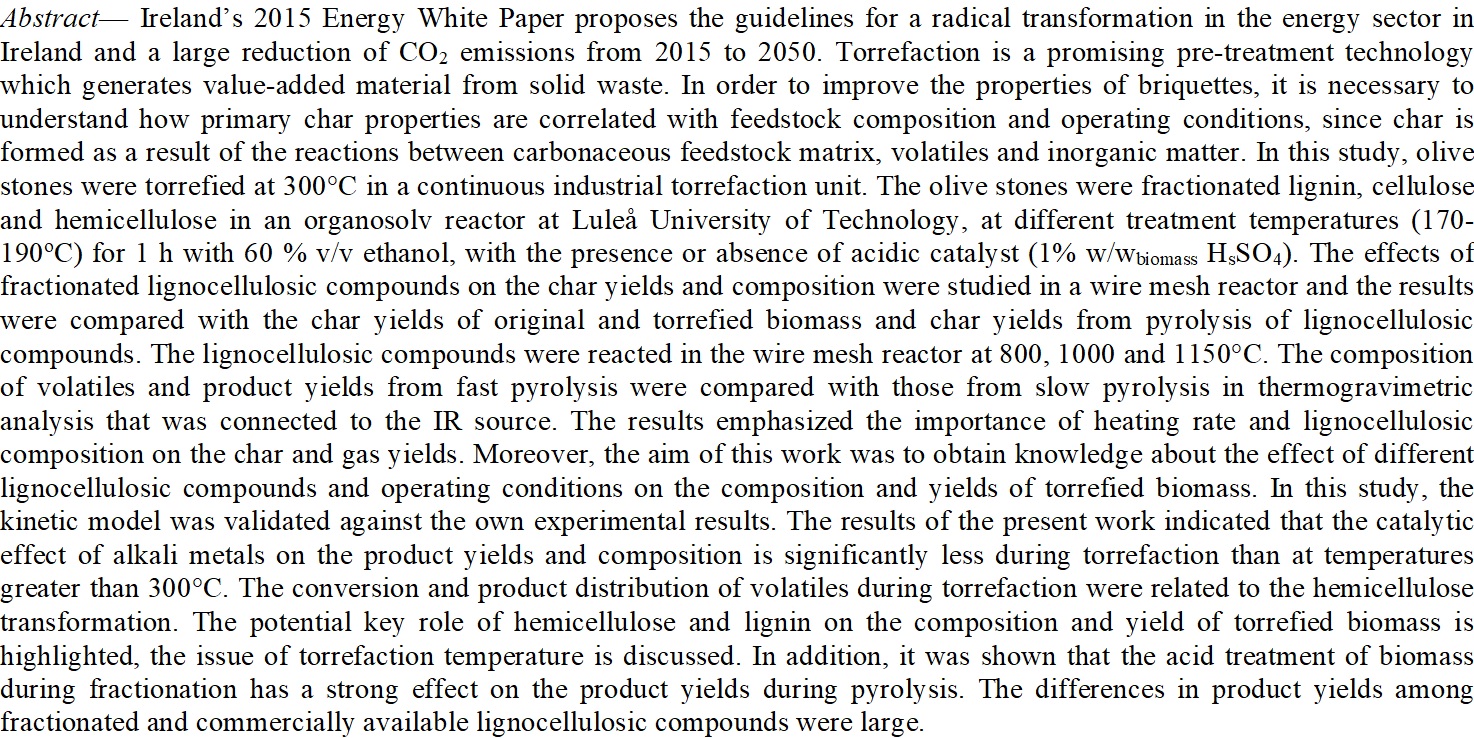2020 Virtual AIChE Annual Meeting
(397e) Fast Pyrolysis of Torrefied Biomass and Lignocellulosic Compounds from Fractionated Olive Stones
Authors
Anna Trubetskaya - Presenter, Danish Technical University
Kaan Gürel, Middle East Technical University
Feyza Kazanc, Middle East Technical University
Italo Pissano, University of Limerick
Duarte Magalhaes, Middle East Technical University
Paul Christakopoulos, Lulea University of Technology
Leonidas Matsakas, Lulea University of Technology
Irelandâs 2015 Energy White Paper proposes the guidelines for a radical transformation in the energy sector in Ireland and a large reduction of CO2 emissions from 2015 to 2050. Torrefaction is a promising pre-treatment technology which generates value-added material from solid waste. In order to improve the properties of briquettes, it is necessary to understand how primary char properties are correlated with feedstock composition and operating conditions, since char is formed as a result of the reactions between carbonaceous feedstock matrix, volatiles and inorganic matter. In this study, olive stones were torrefied at 300°C in a continuous industrial torrefaction unit. The olive stones were fractionated lignin, cellulose and hemicellulose in an organosolv reactor at LuleÃ¥ University of Technology, at different treatment temperatures (170-190oC) for 1 h with 60 % v/v ethanol, with the presence or absence of acidic catalyst (1% w/wbiomass HsSO4). The effects of fractionated lignocellulosic compounds on the char yields and composition were studied in a wire mesh reactor and the results were compared with the char yields of original and torrefied biomass and char yields from pyrolysis of lignocellulosic compounds. The lignocellulosic compounds were reacted in the wire mesh reactor at 800, 1000 and 1150°C. The composition of volatiles and product yields from fast pyrolysis were compared with those from slow pyrolysis in thermogravimetric analysis that was connected to the IR source. The results emphasized the importance of heating rate and lignocellulosic composition on the char and gas yields. Moreover, the aim of this work was to obtain knowledge about the effect of different lignocellulosic compounds and operating conditions on the composition and yields of torrefied biomass. In this study, the kinetic model was validated against the own experimental results. The results of the present work indicated that the catalytic effect of alkali metals on the product yields and composition is significantly less during torrefaction than at temperatures greater than 300°C. The conversion and product distribution of volatiles during torrefaction were related to the hemicellulose transformation. The potential key role of hemicellulose and lignin on the composition and yield of torrefied biomass is highlighted, the issue of torrefaction temperature is discussed. In addition, it was shown that the acid treatment of biomass during fractionation has a strong effect on the product yields during pyrolysis. The differences in product yields among fractionated and commercially available lignocellulosic compounds were large.


